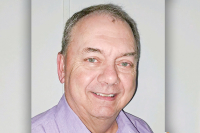A diverse portfolio: Seed bank works to protect genes of WNC plants
 Plant ‘vouchers’ preserve fruiting sprigs of various native plants and record information such as location found and date of fruiting. Holly Kays photos
Plant ‘vouchers’ preserve fruiting sprigs of various native plants and record information such as location found and date of fruiting. Holly Kays photos
It’s been just about 10 years since the day Joe-Ann McCoy, then living in Iowa and working as the national medicinal plant curator for the U.S. Department of Agriculture, got a life-changing call from her home region of Western North Carolina.
It was the N.C. Arboretum in Asheville, and they wanted to know if she’d be interested in trading her secure government job for a position funded by grants and contracts, moving to the Asheville area, and starting up a seed bank.
“There was nothing here. There wasn’t a single lab,” McCoy said.
Banking for the future
Since taking on the project in early 2008, McCoy, Ph.D., has built from the ground up a program that now includes three labs and the lofty mission of conserving, studying and identifying uses for the region’s proliferation of native plant species.
“It serves numerous purposes,” McCoy said of the seed bank, called the N.C. Arboretum Germplasm Repository. “It’s long-term conservation, it’s economic development, it’s finding nutritive compounds for potential growers in the region to grow as crops. It can be drug discovery. It can be endophyte discovery. The whole collection turns into a research tool.”
Related Items
So far, McCoy — assisted by one staff technician and a rotating cast of volunteers and student interns — has preserved seed from about 2,000 species of plants, most of them stored in vacuum-sealed bags filed in a freezer set to -4 degrees Fahrenheit. Those seeds are known as “orthodox” seeds and account for about 95 percent of plant species. The remaining 5 percent, known as “recalcitrant” seed, must be stored at a substantially lower temperature to remain viable — they are preserved in a container of liquid nitrogen. Every decade or two, seeds are retrieved from the freezer, tested for viability, and then returned to cold storage.

“This isn’t just seed banking for year-to-year,” McCoy said. “This is seed banking for long-term.”
Years from now, if a species goes extinct or becomes so rare that its genetic diversity is threatened, the hope is the existence of a seed bank will mean that the species could one day be restored to the landscape. The bank also maintains a file of plant “vouchers,” cards that each feature a dried sprig of a fruiting plant along with information such as the date of fruiting and location found.
Preserving seeds is far from being the only way McCoy spends her time these days. When she was originally hired, state funding supported the seed-banking mission, but over the years that funding has dwindled to nothing. As a result, she spends at least half of her time working on research contracts she accepts in order to support the unfunded seed bank work.
“We came here to start the seed bank, but it has turned into not being our main project because it’s not funded by the state,” she said. “I would like to see the seed bank be the main focus, but research and product development are also a large focus.”
Demotivating poachers
That’s not to say that the research contracts don’t often involve some fascinating projects. Perhaps the most exciting area McCoy has found herself exploring is endophyte research.
Like gut microbes that live in human digestive systems, endophytes are living organisms that live inside of plants — 10 to 20 different microbes per plant, passed down through the seed. Widespread use of pesticides and herbicides can kill these microbes, however, thereby changing the medicinal value of future generations. Microbes can also vanish through sterile breeding.
About eight years ago, McCoy started an endophyte collection — the microbes are extracted from plant samples, separated out into their individual types, and then propagated so that the lab can continue to have a supply of endophytes without harvesting more plants. From there, the research looks at the microbes’ medicinal value.
“We need to preserve as much of it as possible and determine if the endophytes have any of the bioactivity the plant has, so we can make a product out of the endophytes and get people away from the plant,” McCoy explained.
Plants prized for their medicinal value often face particular pressures in the wild from poachers who harvest them beyond their ability to repopulate. If scientists could identify the compounds that create that sought-after medicinal effect, the thought is, then they could grow the substance in labs without harm to the wild population.
Of course, the poster child for medicinal plants facing undue pressure from poaching is ginseng, and ginseng is unlikely to benefit from endophyte research.
“The price is getting way too high, and that’s a death wish on a plant,” McCoy said.

Wild ginseng roots, found in the mountains of Western North Carolina, can sell for hundreds of dollars per pound in Asian markets, which value them for a variety of medicinal effects. That high price tag motivates many to illegally harvest it, and it puts substantial pressure on a plant that’s already finicky about its growing conditions. Ginseng requires a very specific type of environment to thrive, and it takes more than five years for a ginseng seed to grow into a plant of harvestable size. Its seeds fall into that 5 percent category of “recalcitrant” seeds that must be stored at extremely low temperatures to remain viable long-term.
“It’s even more in trouble than people think it is,” McCoy said.
Unfortunately, Asian buyers value it as much for the gnarled shape of its roots as for the purported medicinal effects, meaning that the marketing of endophytic ginseng compounds might not have much effect on demand.
“I work with a lot of medicinal plants, and this one is all visual,” McCoy said. “It could be that the microbes in the soil are making it get more gnarled. That would be great if we could find something like that associated with it.”
Lessons from the Cherokee
Clearly, there’s much more yet to learn.
But for McCoy, moving forward means looking backward to the practices of this region’s earliest residents — the Cherokee.
There’s an “unwritten law” in the world of plant collection, she said, that says the first thing a collector should do upon arriving in a new place is to get in touch with the native people. So, when she arrived in North Carolina to start the seed bank, she was quick to contact the Eastern Band of Cherokee Indians.
“Ever since I’ve started, we’ve had a project going,” she said.
Currently, she’s working on seven grant-funded programs through the tribe, including helping the EBCI set up its own seed bank. The idea is apparently catching on in Indian Country, with McCoy giving a talk last year to more than 20 tribal chiefs during a United Southeastern Tribes conference in New York on the virtues of seed banks. The tribes wound up signing a memorandum of understanding to start an intertribal seed bank program.
“We’re working toward getting that funded too, because the tribes don’t have a seed bank set up,” she said.
McCoy is also working on a pair of high-stakes projects with the EBCI that could result in tribal members being able to gather culturally important plants on national park land. An agreement with the Great Smoky Mountains National Park concerning sochan — also known as green-headed coneflower — is pending following research McCoy conducted showing that the Cherokee method of harvesting actually benefits the plant’s ability to reproduce.
She’s now working on a similar study to compare how ramps are impacted when the plants are left alone, harvested via the non-Cherokee method of digging up the whole plant, or harvested via the Cherokee method of slicing the plant at the base. The study will run for two or three years before concluding, but so far, McCoy said, it’s looking like the Cherokee method is sustainable.
From that standpoint, it seems as though tribal members know something that science has only recently figured out. According to tribal tradition, McCoy said, harvesters should pass by three plants before harvesting one plant — a 25 percent harvest rate. The National Plant Germplasm System has a similar mandate. Collectors aren’t supposed to take more than 20 percent from a population.
“It’s kind of interesting that they’re that similar, because the USDA did a scientific study and came up with that number,” McCoy said.
The ongoing research on endophytes may corroborate another longstanding Cherokee assertion — that place, not just species, is important when collecting plants.
“What we’ve found is that this population is going to have different bioactivity than that population due to the microbes,” McCoy said. “That could justify why they were so determined they had to go to this population (in the Smokies) where they were banned.”
It’s been 10 years, but the job is far from done. And, as far as McCoy is concerned, it never will be. There will always be more species to collect, more diversity within species to strive for, and more to learn about how best to conserve the plants that make Western North Carolina what it is.
“A seed bank is a never-ending thing. You never get caught up,” she said. “There’s always more species.”
Learn more about the N.C. Arboretum Germplasm Repository at www.ncarboretum.org/impact/germplasm-repository.









